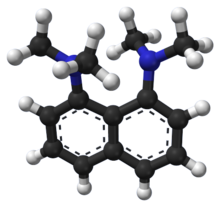1,8-Bis(dimethylamino)naphthalene

| |

| |
| Names | |
|---|---|
| IUPAC name
N,N,N',N'-tetramethylnaphthalene-1,8-diamine
| |
| Other names
Proton Sponge
| |
| Identifiers | |
3D model (JSmol)
|
|
| ChemSpider | |
| ECHA InfoCard | 100.039.986 |
PubChem CID
|
|
CompTox Dashboard (EPA)
|
|
| |
| |
| Properties | |
| C14H18N2 | |
| Molar mass | 214.312 g·mol−1 |
| Melting point | 47.8 °C (118.0 °F; 320.9 K) |
| Acidity (pKa) | 12.1 (in water)[1] 18.62 (in acetonitrile)[2] |
Except where otherwise noted, data are given for materials in their standard state (at 25 °C [77 °F], 100 kPa).
| |
1,8-Bis(dimethylamino)naphthalene is an organic compound with the formula C10H6(NMe2)2 (Me = methyl). It is classified as a peri-naphthalene, i.e. a 1,8-disubstituted derivative of naphthalene. Owing to its unusual structure, it exhibits exceptional basicity. It is a colorless liquid. It is often referred by the trade name Proton Sponge, a trademark of Sigma-Aldrich.[3]
Structure and properties
This compound is a diamine in which the two dimethylamino groups are attached on the same side or peri position of a naphthalene system. Proton-sponge has several very interesting properties; one is its very high basicity; another is its spectroscopic properties.
With a pKa of 12.34 [4] for its conjugate acid in aqueous solution, 1,8-bis(dimethylamino)naphthalene is one of the strongest amine bases. It only absorbs protons slowly—hence the trade name. The high basicity is attributed to the relief of strain upon protonation and/or the strong interaction between the nitrogen lone pairs.[3] It is sterically hindered, making it a weak nucleophile. Because of this combination of properties, it has been used in organic synthesis as a highly selective non-nucleophilic base.[4]
Preparation
This compound is commercially available. It may be prepared by the methylation of 1,8-diaminonaphthalene with iodomethane or dimethyl sulfate.[5]
Reactions
Proton-sponge is methylated by using dimethyl sulfate. The pKa of trimethylated Proton-sponge is 6.43 in aqueous solution.[citation needed]
Related compounds
Other proton sponges
Second generation proton sponges are known with even higher basicity. 1,8-bis(hexamethyltriaminophosphazenyl)naphthalene or HMPN[6] is prepared from 1,8-diaminonaphthalene by reaction with tris(dimethylamino)bromophosphonium bromide in the presence of triethylamine. HMPN has a pKBH+ of 29.9 in acetonitrile which is more than 11 orders of magnitude higher than Proton Sponge.
Hydride sponge
The chemical inverse of a proton sponge would be a hydride sponge. This property is exhibited by C10H6(BMe2)2, which reacts with potassium hydride to afford K[C10H6(BMe2)2H].
References
- ^ R. W. Alder; P. S. Bowman; W. R. S. Steele; D. R. Winterman (1968). "The remarkable basicity of 1,8-bis(dimethylamino)naphthalene". Chem. Commun. (13): 723. doi:10.1039/C19680000723.
{{cite journal}}: Unknown parameter|last-author-amp=ignored (|name-list-style=suggested) (help) - ^ I. Kaljurand, A. Kütt, L. Sooväli, T. Rodima, V. Mäemets, I. Leito, I. A. Koppel. Extension of the Self-Consistent Spectrophotometric Basicity Scale in Acetonitrile to a Full Span of 28 pKa Units: Unification of Different Basicity Scales. J. Org. Chem., 2005, 70, 1019–1028. doi:10.1021/jo048252w
- ^ a b R. W. Alder (1989). "Strain effects on amine basicities". Chem. Rev. 89 (5): 1215–1223. doi:10.1021/cr00095a015.
- ^ a b Alexander F. Pozharskii and Valery A. Ozeryanskii "Proton sponges and hydrogen transfer phenomena" Mendeleev Commun., 2012, 22, 117–124. doi:10.1016/j.mencom.2012.05.001
- ^ Sorokin, Vladimir I.; Ozeryanskii, Valery A.; Pozharskii, Alexander F. (2003). "A Simple and Effective Procedure for the N-Permethylation of Amino-Substituted Naphthalenes". European Journal of Organic Chemistry. 2003 (3): 496. doi:10.1002/ejoc.200390085.
- ^ Volker Raab; Ekaterina Gauchenova; Alexei Merkoulov; Klaus Harms; Jörg Sundermeyer; Borislav Kovačević; Zvonimir B. Maksić (2005). "1,8-Bis(hexamethyltriaminophosphazenyl)naphthalene, HMPN: A Superbasic Bisphosphazene "Proton Sponge"". J. Am. Chem. Soc. 127 (45): 15738–15743. doi:10.1021/ja052647v. PMID 16277515.
{{cite journal}}: Unknown parameter|last-author-amp=ignored (|name-list-style=suggested) (help)
